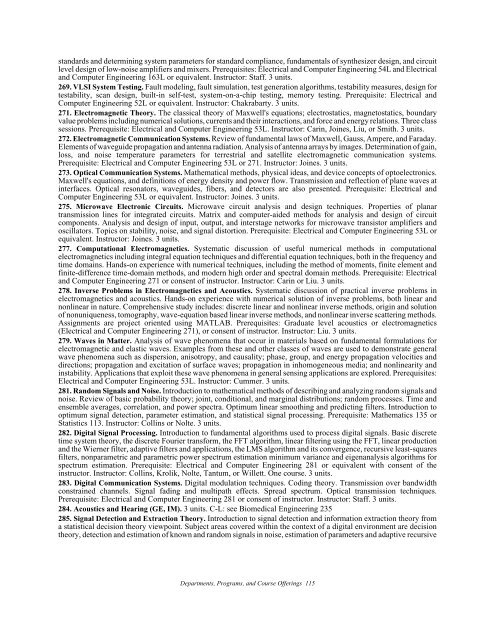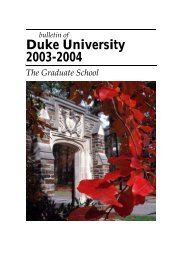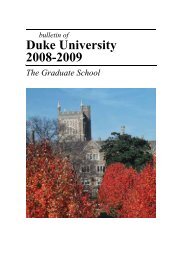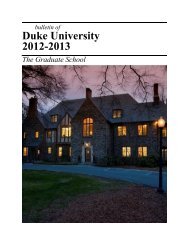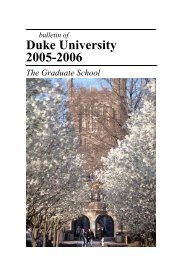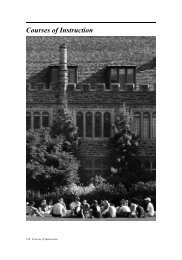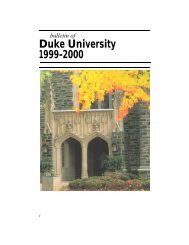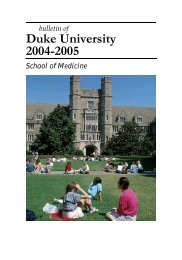Duke University 2009-2010 - Office of the Registrar - Duke University
Duke University 2009-2010 - Office of the Registrar - Duke University
Duke University 2009-2010 - Office of the Registrar - Duke University
Create successful ePaper yourself
Turn your PDF publications into a flip-book with our unique Google optimized e-Paper software.
standards and determining system parameters for standard compliance, fundamentals <strong>of</strong> syn<strong>the</strong>sizer design, and circuit<br />
level design <strong>of</strong> low-noise amplifiers and mixers. Prerequisites: Electrical and Computer Engineering 54L and Electrical<br />
and Computer Engineering 163L or equivalent. Instructor: Staff. 3 units.<br />
269. VLSI System Testing. Fault modeling, fault simulation, test generation algorithms, testability measures, design for<br />
testability, scan design, built-in self-test, system-on-a-chip testing, memory testing. Prerequisite: Electrical and<br />
Computer Engineering 52L or equivalent. Instructor: Chakrabarty. 3 units.<br />
271. Electromagnetic Theory. The classical <strong>the</strong>ory <strong>of</strong> Maxwell's equations; electrostatics, magnetostatics, boundary<br />
value problems including numerical solutions, currents and <strong>the</strong>ir interactions, and force and energy relations. Three class<br />
sessions. Prerequisite: Electrical and Computer Engineering 53L. Instructor: Carin, Joines, Liu, or Smith. 3 units.<br />
272. Electromagnetic Communication Systems. Review <strong>of</strong> fundamental laws <strong>of</strong> Maxwell, Gauss, Ampere, and Faraday.<br />
Elements <strong>of</strong> waveguide propagation and antenna radiation. Analysis <strong>of</strong> antenna arrays by images. Determination <strong>of</strong> gain,<br />
loss, and noise temperature parameters for terrestrial and satellite electromagnetic communication systems.<br />
Prerequisite: Electrical and Computer Engineering 53L or 271. Instructor: Joines. 3 units.<br />
273. Optical Communication Systems. Ma<strong>the</strong>matical methods, physical ideas, and device concepts <strong>of</strong> optoelectronics.<br />
Maxwell's equations, and definitions <strong>of</strong> energy density and power flow. Transmission and reflection <strong>of</strong> plane waves at<br />
interfaces. Optical resonators, waveguides, fibers, and detectors are also presented. Prerequisite: Electrical and<br />
Computer Engineering 53L or equivalent. Instructor: Joines. 3 units.<br />
275. Microwave Electronic Circuits. Microwave circuit analysis and design techniques. Properties <strong>of</strong> planar<br />
transmission lines for integrated circuits. Matrix and computer-aided methods for analysis and design <strong>of</strong> circuit<br />
components. Analysis and design <strong>of</strong> input, output, and interstage networks for microwave transistor amplifiers and<br />
oscillators. Topics on stability, noise, and signal distortion. Prerequisite: Electrical and Computer Engineering 53L or<br />
equivalent. Instructor: Joines. 3 units.<br />
277. Computational Electromagnetics. Systematic discussion <strong>of</strong> useful numerical methods in computational<br />
electromagnetics including integral equation techniques and differential equation techniques, both in <strong>the</strong> frequency and<br />
time domains. Hands-on experience with numerical techniques, including <strong>the</strong> method <strong>of</strong> moments, finite element and<br />
finite-difference time-domain methods, and modern high order and spectral domain methods. Prerequisite: Electrical<br />
and Computer Engineering 271 or consent <strong>of</strong> instructor. Instructor: Carin or Liu. 3 units.<br />
278. Inverse Problems in Electromagnetics and Acoustics. Systematic discussion <strong>of</strong> practical inverse problems in<br />
electromagnetics and acoustics. Hands-on experience with numerical solution <strong>of</strong> inverse problems, both linear and<br />
nonlinear in nature. Comprehensive study includes: discrete linear and nonlinear inverse methods, origin and solution<br />
<strong>of</strong> nonuniqueness, tomography, wave-equation based linear inverse methods, and nonlinear inverse scattering methods.<br />
Assignments are project oriented using MATLAB. Prerequisites: Graduate level acoustics or electromagnetics<br />
(Electrical and Computer Engineering 271), or consent <strong>of</strong> instructor. Instructor: Liu. 3 units.<br />
279. Waves in Matter. Analysis <strong>of</strong> wave phenomena that occur in materials based on fundamental formulations for<br />
electromagnetic and elastic waves. Examples from <strong>the</strong>se and o<strong>the</strong>r classes <strong>of</strong> waves are used to demonstrate general<br />
wave phenomena such as dispersion, anisotropy, and causality; phase, group, and energy propagation velocities and<br />
directions; propagation and excitation <strong>of</strong> surface waves; propagation in inhomogeneous media; and nonlinearity and<br />
instability. Applications that exploit <strong>the</strong>se wave phenomena in general sensing applications are explored. Prerequisites:<br />
Electrical and Computer Engineering 53L. Instructor: Cummer. 3 units.<br />
281. Random Signals and Noise. Introduction to ma<strong>the</strong>matical methods <strong>of</strong> describing and analyzing random signals and<br />
noise. Review <strong>of</strong> basic probability <strong>the</strong>ory; joint, conditional, and marginal distributions; random processes. Time and<br />
ensemble averages, correlation, and power spectra. Optimum linear smoothing and predicting filters. Introduction to<br />
optimum signal detection, parameter estimation, and statistical signal processing. Prerequisite: Ma<strong>the</strong>matics 135 or<br />
Statistics 113. Instructor: Collins or Nolte. 3 units.<br />
282. Digital Signal Processing. Introduction to fundamental algorithms used to process digital signals. Basic discrete<br />
time system <strong>the</strong>ory, <strong>the</strong> discrete Fourier transform, <strong>the</strong> FFT algorithm, linear filtering using <strong>the</strong> FFT, linear production<br />
and <strong>the</strong> Wierner filter, adaptive filters and applications, <strong>the</strong> LMS algorithm and its convergence, recursive least-squares<br />
filters, nonparametric and parametric power spectrum estimation minimum variance and eigenanalysis algorithms for<br />
spectrum estimation. Prerequisite: Electrical and Computer Engineering 281 or equivalent with consent <strong>of</strong> <strong>the</strong><br />
instructor. Instructor: Collins, Krolik, Nolte, Tantum, or Willett. One course. 3 units.<br />
283. Digital Communication Systems. Digital modulation techniques. Coding <strong>the</strong>ory. Transmission over bandwidth<br />
constrained channels. Signal fading and multipath effects. Spread spectrum. Optical transmission techniques.<br />
Prerequisite: Electrical and Computer Engineering 281 or consent <strong>of</strong> instructor. Instructor: Staff. 3 units.<br />
284. Acoustics and Hearing (GE, IM). 3 units. C-L: see Biomedical Engineering 235<br />
285. Signal Detection and Extraction Theory. Introduction to signal detection and information extraction <strong>the</strong>ory from<br />
a statistical decision <strong>the</strong>ory viewpoint. Subject areas covered within <strong>the</strong> context <strong>of</strong> a digital environment are decision<br />
<strong>the</strong>ory, detection and estimation <strong>of</strong> known and random signals in noise, estimation <strong>of</strong> parameters and adaptive recursive<br />
Departments, Programs, and Course Offerings 115


